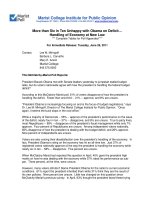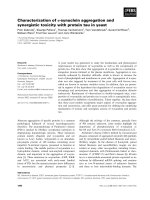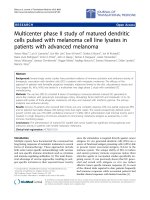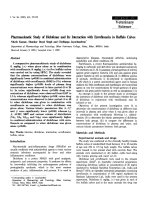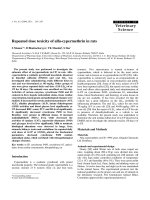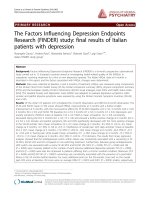Haemato-biochemical study: Induced Beta cyfluthrin repeated toxicity with reversal on Wistar rats
Bạn đang xem bản rút gọn của tài liệu. Xem và tải ngay bản đầy đủ của tài liệu tại đây (462.52 KB, 12 trang )
Int.J.Curr.Microbiol.App.Sci (2019) 8(3): 100-111
International Journal of Current Microbiology and Applied Sciences
ISSN: 2319-7706 Volume 8 Number 03 (2019)
Journal homepage:
Original Research Article
/>
Haemato-biochemical Study: Induced Beta Cyfluthrin Repeated Toxicity
with Reversal on Wistar Rats
H.C. Parmar*, J.K. Raval, J.M. Patel, P.D. Vihol, I.H. Kalyani and M.C. Prasad
Department of Veterinary Pathology, College of Veterinary Science and A. H.
Navsari Agricultural University, Navsari – 396 450, Gujarat, India
*Corresponding author
ABSTRACT
Keywords
Beta cyfluthrin,
Pyrethroid,
Haematobichemical
Alteration, Rat
Article Info
Accepted:
04 February 2019
Available Online:
10 March 2019
Beta cyfluthrin is widely used multipurpose synthetic pyrethroid. Indiscriminate uses
resulting to deleterious effects in animal metabolism. Present study has been designed to
investigate the effects of beta cyfluthrin on haemato-biochemical alteration in both the
sexes of Wistar rats (Rattus norvegicus). Beta cyfluthrin was orally administered, 38.0
mg/kg b. wt. (high dose), 12.66 mg/kg b. wt. (mid dose), 4.22 mg/kg b. wt. (low dose) for
90 days with high dose recovery. Beta cyfluthrin caused marked reduction in Hb
concentration, RBCs count, haematocrit, MCH, platelets, lymphocytes whereas an
increased in TLC and neutrophil count at different intervals in both the sexes. Serum
activities of AST, ALT, ALP, LDH and concentration of total proteins, globulin,
creatinine, blood urea nitrogen, glucose, total bilirubin, total cholesterol, triglyceride and
total lipids was increased whereas albumin, A:G ratio, sodium and chlorides were
significantly decreased. Results showed that liver and kidneys were affected due to toxicity
of beta cyfluthrin. Recovery period brought all these parameters within normal range but
lipid profile which remained at higher level even after withdrawal of treatment. Thus, beta
cyfluthrin should be used with cautiously under areas before untargeted animals.
Introduction
Pesticides are the most effective means of pest
eradication all over the world but their use has
reached an alarming rate due to a number of
adverse effects on non target organisms
(Bhusan et al., 2013a). Pyrethroid pesticides
are broadly divided in to type I and II,
depending upon absence and presence of alpha
cyno group, respectively and their produced
behavioral changes (Sayim et al., 2005;
Wolansky et al., 2006). Beta cyfluthrin, the
refined form of synthetic pyrethroids are
currently being used in many formulations
around the world. It belongs to the type II
class of synthetic pyrethroids and act as a
contact and stomach poison. It is a nonsystemic chemical used to control ectoparasites in animals as topical application and
also control of insects like cutworms,
cockroaches, termites, mosquitoes, fleas, flies,
tobacco budworm, etc. Beta cyfluthrin based
insecticide formulations are available in the
form of emulsifiable concentrates, wettable
100
Int.J.Curr.Microbiol.App.Sci (2019) 8(3): 100-111
powder, aerosol, granules, liquid, oil-in-water
emulsion and oil spray. Injudicious uses create
detrimental effect on host. Pyrethroids are
known to have toxic potential in mammals
affecting liver, kidneys and their functions in
either sex by a number of researchers
(Tuzmen et al., 2008; Mani et al., 2004;
Okuno et al., 1986; Sakr, 1999).
The aim of the study was to evaluate toxicity
of beta cyfluthrin on wistar rats in serum
haemato-biochemical changes. In addition, the
study was extended up to concomitant
recovery phase of fourteen days following
ninety days of beta cyfluthrin exposure, to
assess possible recovery from intoxication.
(For main study Gr.1 to 4) and 104th day
(recovery control and recovery high dose of
Gr.5 and 6) of experiment for hematological in
K2 EDTA (anticoagulant) containing vial and
biochemical parameters estimations in plain
vial for separation of serum samples. At the
end day of experiment, the surviving rats of
main experiment four groups (Gr.1 to 4 at 90
days) and recovery two groups (Gr.5 and 6 at
104 days) were subjected to terminal sacrifice
by over dose of ether inhalation followed by
cervical dislocation after collection of blood.
The data generated during experiment were
subjected to statistical procedure given by
(Snedecor and Cochran, 1980).
Results and Discussion
Materials and Methods
Haematological parameters
The toxicity study of beta cyfluthrin was
carried out with maintained animal welfare
protocol on 120 rats having 6-7 weeks of age,
acclimatized one week to laboratory condition
prior to dose administration. The animals were
maintained under standard conditions of light
and temperature provided, standard rat pellet
feed (M/S VRK Nutritional Solutions, Pune)
and water ad libitum throughout the study.
Rats were randomly divided into six different
groups with 10 males and 10 females in each
group. Gr.1 to Gr.4 as a main study groups
and Gr.5 acted as control recovery group
while Gr.6 acted as high dose recovery group.
After 90 days of oral dosing, beta cyfluthrin
was discontinued for 14 days. Technical grade
beta cyfluthrin (purity >99%) procured from
M/S Krishi Rasayan Exports Pvt. Ltd.,
Ahmedabad was dissolved in carboximethyl
cellulose (CMC) and administered orally to
rats of Gr.2 to 4 in graded dose (4.22 mg/kg b.
wt, 12.66 mg/kg b. wt, 38.0 mg/kg b. wt.).
Rats were anaesthetized using diethyl ether for
blood collection. Blood samples were
collected from retro orbital venous plexus
using rat capillaries at 28th, 56th and 90th day
A significant decrease in the mean of Hb,
RBCs count, haematocrit, MCH, platelets,
lymphocytes whereas an increased in of TLC
and neutrophils count was observed in low
dose (Gr.2), mid dose (Gr.3) and high dose
(Gr.4) at different intervals (i.e. 28th, 56th and
90th day) of beta cyfluthrin treatment (Table 1)
but a few parameters like MCH and RBCs did
not fall in line of above observation at 90th day
of treatment and parameters except TLC and
neutrophils came in normal range during post
recovery period of two weeks. In other words
TLC and neutrophils count remained
increased even after withdrawal of treatment
in either sex (Table 2).
Pyrethroids are known to induce toxic effects
on various haematopoitic tissues in two ways:
either by interference with mature components
flowing in peripheral blood or with
development of such integral blood
components (Bhushan et al., 2013a). A
decreased count in total red cells in present
study following beta cyfluthrin intoxication is
an indicator of interference of the
experimental pesticides as well as its
101
Int.J.Curr.Microbiol.App.Sci (2019) 8(3): 100-111
metabolically broken down byproducts
causing lysis of erythrocytes resulting in its
decrease in circulation (Shakoori et al., 1990;
Ahmad et al., 2009; Abbassy and Mossa,
2012). Decreased haematocrit value as
observed in the present study correlate with
reduced
RBC
count
coupled
with
hypohaemoglobinaemia accompanied by
hypoplasia of bone marrow and anemia
(Pande, 2001; Jain et al., 2009; Abbassy &
Mossa, 2012). Decreased the value of MCH
may be attributed to microcytic anemia
following beta
cyfluthrin
intoxication
quantitatively. Decrease in MCHC value
seemed to be the result of microcytosis of red
blood cells. Further increased value (%) of
total leucocytes count was found to be the
outcome of an increase in neutrophil on one
hand a decrease of lymphocyte count in the
present study increase count of neutrophil
would have been a outcome of stimulated
granulocyte precursors to produce more
neutrophils while cytotoxic effects of beta
cyfluthrin on the immunological organs where
lymphocytes are formed (Wang et al., 2009).
Biochemical parameters
A dose dependent significant (P<0.05)
increase in the activities of AST, ALT, ALP
and LDH was observed in both the sexes at all
the dose levels (low, mid and high) when
compared to the control group at 28th, 56th and
90th day of treatment (Table 3). But recovery
period brought theses enzyme activities within
normal range (Table 4). Broadly the present
finding supported the observations of a
number of earlier workers (Bhushan et al.,
2013a; Yadav and Saxena, 2014; Samia et al.,
2017). The activities of theses liver enzymes
increases due to various hepatotoxic
xenobiotics substances. It has been suggested
by various workers in past that such a rise in
an above mentioned hepatic enzymes is the
outcome of hepatotoxic effects produced by
various agents. The hepatotoxic injuries due to
any reason are held responsible for rise of
these enzymes in blood circulation (Samia et
al., 2017). Whereas it has been suggested that
similar rise in the activities of ALP and LDH
is due to hepatocytic proliferation or improper
functioning of hepatobiliary system (Gupta
and Kumar, 1991).
A significant (P<0.05) increase in serum
concentration of total proteins and globulin
whereas decrease in albumin and A:G ratio
were seen in all the groups (Gr.2, 3 and 4) at
different interval period (28th, 56th and 90th) in
either sex of the rats (Table 5) and became
normal during recovery period (Table 6). An
increase was recorded in total proteins
concentration in serum of rats exposed to beta
cyfluthrin in this study might be due to
increased leakage of liver enzyme and
disturbances in protein catabolism while a
decreased in albumin concentration might be
due to liver dysfunction and disturbance in the
biosynthesis of albumin in hepatocytes
(Shakoori et al., 1988). In contrast, increased
level of globulin concentration might be due
to the toxic stress of beta cyfluthrin (Rifat et
al., 2012). Pyrethroids induced stress leads the
release of adrenocorticotropic hormone
(ACTH) activating secretion of cortisol by
adrenal cortex (Hayes and Laws, 1991). The
increase in this hormone leads to reduced
cellular protein stores. Therefore protein
synthesis by hepatocytes comes to be out into
blood increasing the protein concentration
(Bhushan et al., 2013b). Similar results
including increase total protein and globulin
while reduced albumin and A:G ratio also
reported in past by many researchers
(Shakoori et al., 1988; Yousef et al., 2006;
Hussain et al., 2009; Waggas, 2013; Samia et
al., 2017) in pyrethroids treatment.
A significant (P<0.05) increase in serum
concentration of creatinine, blood urea
nitrogen, glucose and total bilirubin was noted
in the groups (Gr. 3 and 4) at all the interval
102
Int.J.Curr.Microbiol.App.Sci (2019) 8(3): 100-111
period (28th, 56th and 90th) in either sex of rats
(Table 5). Suggesting that kidney damage
caused by beta cyfluthrin is recovered in 14
days if the toxic agent is discontinued. Serum
creatinine and BUN are two main parameters
to judge the health of kidneys. Creatinine is
the breakdown product of muscle protein
while it cleared and execrated from the
kidneys. Higher level seen in experiment Gr. 3
and 4 indicated excessive breakdown of
muscle protein which was dose and duration
dependent. The value in high dose recovery
group (Gr.6) also suggested that the damage
occurring in kidneys was amenable to recover
properly. The increased bilirubin might be due
to liver cell damage because liver played
major role in bilirubin metabolism which
probably was inflammation in the present
study resulting in disturbed bile excretion,
might be responsible for hyperbilirubinemia
intoxicated rats (Bhushan et al., 2013b). High
glucose level in serum was also the outcome
of beta cyfluthin toxicity. Hyperglycemia
might be due to involvement of adrenal
medulla in treated rats. There is every likely
hood that beta cyfluthrin might not have killed
beta cells of Islets of Langerhans out right but
could have depressed beta cells activity thus
affecting glucose metabolism but it need
further elucidation. Our results revealed the
clear dose dependent increase in blood urea
nitrogen and creatinine levels in serum by
toxic effect of beta cyfluthrin exposure. The
increased these parameters might be attributed
to the decrease in glomerular filtration, tubules
dysfunction and kidney damage (Verma et al.,
2013). Similar results reported in past by
many researchers (Yousef et al., 2006; Fetoui
et al., 2009; Waggas, 2013; Samia et al.,
2017).
A significant (P<0.05) increase in the level of
serum total cholesterol, triglyceride and total
lipids was seen in rats of treated Gr.2, 3 and 4
at all the intervals (28th, 56th and 90th) in either
sex of rats (Table 7). The recovery period of
14 days did not bring improvement in lipid
profile (Table 8). Suggesting that energy crisis
developed during study period of 90 days
continue. Any increase in the level of these
forms might increase total lipids concentration
in serum. One of the causes of increased total
lipid concentration appears to be the
disturbance of carbohydrate metabolism due
to probable cytotoxic effect of beta cyfluthrin
on cells of the pancreas leading to relative
deficiency of insulin (Guyton and Hall, 2001).
Table.1 Hematological values in main groups at different time intervals
Parameters
Studied
TLC
(x 103/µL)
TEC
(x 106/µL)
Hb
(g/dL)
Groups
N=10
Day 28
a
Male
Day 56
a
Day 90
a
Day 28
a
Female
Day 56
a
Day 90
Gr.1
7.65 ±0.35
8.02 ±6.37
7.03 ±0.41
5.48 ±0.36
6.37 ±0.18
5.38a±0.96
Gr.2
7.99a±0.49
8.80a±7.35
8.23a±0.48
5.72a±0.30
7.35b±0.56
6.13bc±0.78
Gr.3
8.30a±0.62
9.00a±7.68
8.47b±0.51
5.99a±0.42
7.68b±0.47
6.77cd±1.42
Gr.4
9.02a±0.62
9.41a±8.61
8.73b±0.49
6.25a±0.57
8.61b±0.47
6.98d±0.81
a
a
a
a
a
Gr.1
7.98 ±0.12
7.98 ±0.05
8.43 ±0.12
7.63 ±0.05
7.43 ±0.10
7.91a±0.39
Gr.2
7.75a±0.15
7.76a±0.12
8.11ab±0.15
7.32a±0.12
7.26a±0.06
7.36b±0.32
Gr.3
7.81a±0.09
7.80a±0.09
8.02b±0.09
7.33a±0.09
7.21a±0.10
7.33b±0.19
Gr.4
7.76a±0.08
7.71b±0.07
7.71b±0.14
7.12b±0.07
7.12b±0.10
7.29b±0.42
Gr.1
15.50a±0.17
16.19a±0.15
15.99a±0.23
15.28a±0.09
15.17a±0.21
15.87a±0.43
Gr.2
14.71ab±0.33
15.24ab±0.16
15.53b±0.31
14.58ab±0.23
14.21ab±0.25
14.78b±0.79
Gr.3
14.86ab±0.31
14.76ab±0.30
14.89b±0.35
14.52ab±0.14
14.10b±0.27
14.57b±0.84
103
Int.J.Curr.Microbiol.App.Sci (2019) 8(3): 100-111
Haematocrit
/PCV (%)
MCV
(fL)
MCH
(pg)
MCHC
(g/dL)
Platelet
(x 103/µL)
Lymphocyte
(%)
Monocyte
(%)
Neutrophils
(%)
Eosinophils
(%)
Basophils
(%)
Gr.4
14.51b±0.27
14.66b±0.35
14.59b±0.35
14.15b±0.20
13.73b±0.22
14.53b±0.64
Gr.1
44.05a±0.47
44.27a±0.36
46.72a±0.56
42.55a±0.53
42.66a±0.41
43.80a±1.34
Gr.2
42.76ab±0.56
43.18ab±0.29
45.07ab±0.42
40.89b±0.52
41.47ab±0.43
42.34b±1.09
Gr.3
ab
42.84 ±0.30
ab
41.91 ±0.40
b
44.20 ±0.62
b
40.92 ±0.32
b
40.99 ±0.37
41.51c±1.87
Gr.4
42.48b±0.47
41.42b±0.37
42.56c±0.40
40.94b±0.46
40.40b±0.32
41.27c±1.41
Gr.1
55.29a±0.83
53.49a±1.03
55.51a±1.12
55.83a±0.98
57.50a±0.75
58.10a±1.57
Gr.2
55.28a±0.66
52.91a±0.73
55.02a±0.72
55.92a±0.57
57.11a±0.54
57.61a±1.50
Gr.3
54.92a±0.51
52.92a±1.14
55.15a±0.84
55.89a±0.36
56.92a±0.49
56.61a±2.49
Gr.4
54.95a±0.52
53.18a±1.50
55.39a±1.15
55.95a±0.66
56.85a±0.95
56.71a±2.89
Gr.1
a
19.24 ±0.29
a
19.23 ±0.23
a
20.29 ±0.17
a
20.04 ±0.18
a
20.24 ±0.10
21.58a±1.02
Gr.2
a
19.06 ±0.62
a
18.69 ±0.30
ab
19.66 ±0.11
a
19.94 ±0.11
a
19.78 ±0.36
20.22ab±0.42
Gr.3
19.07a±0.46
18.63a±0.52
19.44ab±0.26
19.95a±0.19
19.93a±0.41
19.93b±0.99
Gr.4
18.80a±0.45
18.88a±0.83
19.02b±0.18
19.44a±0.38
19.63a±0.64
20.13ab±1.53
Gr.1
35.20a±0.37
36.18a±0.24
34.25a±0.45
35.67a±0.47
35.49a±0.48
36.08a±2.40
Gr.2
34.43a±0.84
35.28a±0.29
34.48a±0.73
35.65a±0.35
34.28a±0.62
34.91a±1.24
Gr.3
34.68a±0.66
35.23a±0.67
33.87a±1.01
35.49a±0.58
34.44a±0.73
35.17a±2.53
Gr.4
a
34.21 ±0.77
a
35.40 ±0.80
a
34.27 ±0.67
a
34.60 ±0.55
a
33.99 ±0.59
35.22a±1.37
Gr.1
928.00a±26.97
968.80a±25.96
797.30a±22.15
890.10a±25.60
925.80a±15.12
829.10a±40.66
Gr.2
916.90a±18.96
952.10a±20.55
679.20b±35.81
869.10ab±17.05
914.10ab±38.00
746.50b±60.26
Gr.3
908.60a±17.99
947.30a±21.38
681.80b±37.97
852.70ab±21.62
864.60b±12.43
730.00b±53.13
Gr.4
887.90a±12.44
921.70a±15.02
629.50b±42.78
843.10ab±34.35
853.00b±28.75
662.10b±102.61
Gr.1
74.62a±4.02
80.96a±0.59
81.17a±0.73
77.27a±1.36
81.23a±0.69
81.61a±2.89
Gr.2
ab
71.72 ±3.15
b
78.69 ±0.63
b
78.83 ±0.76
a
76.54 ±1.82
b
79.61 ±1.12
79.49b±3.45
Gr.3
bc
70.00 ±4.12
b
78.24 ±0.85
b
77.79 ±1.02
a
75.90 ±0.90
b
79.26 ±0.66
78.64b±3.03
Gr.4
67.11c±5.90
77.16b±0.73
76.87b±1.75
74.66a±1.37
78.13b±0.87
78.42b±2.88
Gr.1
3.08a±0.11
2.59a±0.10
2.69a±0.15
2.68a±0.16
2.48a±0.12
2.37a±0.42
Gr.2
2.96a±0.14
2.55a±0.08
2.65a±0.07
2.66a±0.14
2.41a±0.06
2.22a±0.36
Gr.3
2.87a±0.13
2.50a±0.10
2.62a±0.07
2.62a±0.16
2.37a±0.08
2.15a±0.40
Gr.4
2.97a±0.10
2.49a±0.12
2.56a±0.10
2.53a±0.15
2.38a±0.05
2.23a±0.37
Gr.1
a
19.40 ±1.34
a
13.75 ±0.96
a
13.33 ±0.84
a
17.95 ±1.10
a
13.39 ±0.82
12.72a±2.27
Gr.2
ab
22.52 ±1.06
b
16.16 ±0.75
ab
15.72 ±0.74
a
18.10 ±1.66
b
15.28 ±1.08
15.49b±3.87
Gr.3
24.63bc±1.29
16.76b±0.92
16.89b±1.03
18.88a±0.70
15.87b±0.62
16.51b±2.89
Gr.4
27.62c±1.92
17.95b±0.91
17.97b±1.89
20.21a±1.88
17.09b±0.96
16.85b±2.90
Gr.1
2.70a±0.30
2.50a±0.34
2.80a±0.25
2.60a±0.34
2.70a±0.30
2.70a±1.16
Gr.2
2.50a±0.27
2.30a±0.30
2.60a±0.22
2.40a±0.22
2.50a±0.17
2.50a±0.85
Gr.3
2.30a±0.21
2.20a±0.20
2.50a±0.22
2.30a±0.26
2.30a±0.26
2.40a±0.70
a
a
a
a
a
Gr.4
2.10 ±0.23
2.10 ±0.23
2.40 ±0.22
2.10 ±0.23
2.20 ±0.20
2.20a±0.79
Gr.1
0.20a±0.13
0.30a±0.30
0.20a±0.13
0.30a±0.15
0.20a±0.13
0.30a±0.48
Gr.2
0.20a±0.13
0.30a±0.30
0.20a±0.13
0.30a±0.15
0.20a±0.13
0.30a±0.48
Gr.3
0.20a±0.13
0.30a±0.30
0.20a±0.13
0.30a±0.15
0.20a±0.13
0.30a±0.48
Gr.4
0.20a±0.13
0.30a±0.30
0.20a±0.13
0.30a±0.15
0.20a±0.13
0.30a±0.48
Note: Means bearing different superscript in a column differ significantly (P < 0.05).
104
Int.J.Curr.Microbiol.App.Sci (2019) 8(3): 100-111
Table.2 Haematological values in recovery groups at 104th day
Parameters Studied
Groups
Male
N=10
Mean±SE
Gr.5
7.65a±0.23
TLC
3
(x 10 /µL)
Gr.6
8.45b±0.28
Gr.5
8.37a±0.16
TEC
6
(x 10 /µL)
Gr.6
8.25a±0.16
Gr.5
16.34a±0.18
Hb
(g/dL
Gr.6
16.10a±0.27
Gr.5
48.10a±0.39
Hematocrit / PCV (%)
Gr.6
47.49a±0.70
Gr.5
57.67a±1.20
MCV
(fL)
Gr.6
57.68a±0.98
Gr.5
19.61a±0.52
MCH
(pg)
Gr.6
19.54a±0.31
Gr.5
33.98a±0.31
MCHC
(g/dL)
Gr.6
33.90a±0.29
Gr.5
774.40a±33.82
Platelet
3
(x 10 /µL
Gr.6
733.90a±25.41
Gr.5
80.07a±0.86
Lymphocyte
(%)
Gr.6
77.28a±0.84
Gr.5
2.66a±0.10
Monocyte
(%)
Gr.6
2.71a±0.14
Gr.5
14.37a±0.63
Neutrophils
(%)
Gr.6
17.11b±0.94
Gr.5
2.70a±0.26
Eosinophils
(%)
Gr.6
2.70a±0.21
Gr.5
0.20a±0.13
Basophils
(%)
Gr.6
0.20a±0.13
Note: Bearing different superscripts in a column differ significantly (P < 0.05).
Female
Mean±SE
5.15a±0.19
5.38a±0.15
7.63a±0.15
7.52a±0.07
15.47a±0.18
15.16a±0.18
43.80a±0.99
44.24a±0.39
58.96a±1.16
58.90a±0.70
20.33a±0.28
20.18a±0.24
34.54a±0.50
34.29a±0.50
773.50a±16.34
755.30a±22.95
76.85a±0.03
75.48a±0.55
2.31a±0.16
2.31a±0.10
18.14a±0.99
19.57a±0.64
2.50a±0.22
2.50a±0.17
0.20a±0.13
0.20a±0.13
Table.3 Average enzyme activities values in different groups at different time intervals
Parameters
Studied
AST
(U/L)
ALT
(U/L)
ALP
(U/L)
LDH
(U/L)
Groups
N=10
Gr.1
Gr.2
Gr.3
Gr.4
Gr.1
Gr.2
Gr.3
Gr.4
Gr.1
Gr.2
Gr.3
Gr.4
Gr.1
Gr.2
Gr.3
Gr.4
Day 28
69.78a±4.40
152.45b±10.18
167.66b±8.83
178.04b±9.53
29.03a±2.99
42.53a±3.55
60.68b±5.72
62.40b±6.27
76.85a±6.00
174.90b±16.74
201.89b±14.00
215.31b±14.38
185.09a±10.54
228.6b±13.16
289.62b±11.13
388.65c±15.04
Male
Day 56
67.52a±6.22
157.47b±10.03
150.53b±11.77
159.71b±11.32
27.98a±2.82
51.64b±4.48
59.97b±6.35
60.74b±6.04
73.80a±6.84
176.10b±14.48
209.86bc±11.06
228.27c±13.92
183.92a±10.99
234.16b±13.97
295.17c±13.49
394.86d±10.73
Day 90
74.02a±5.10
150.20b±9.13
153.80b±10.28
180.32c±12.24
30.32a±2.99
52.38b±5.65
58.96b±4.62
64.20b±5.45
72.72a±6.37
196.01b±13.44
216.91bc±9.13
224.54c±11.84
182.51a±7.75
238.69b±11.93
327.42c±11.42
419.22d±14.43
Day 28
83.25a±4.93
170.79b±12.49
195.53b±14.85
199.07b±13.43
28.45a±2.26
40.69a±3.15
49.63b±4.03
66.67c±5.33
71.76a±5.12
118.72b±11.29
170.93c±11.09
194.53c±16.54
179.47a±10.65
218.74b±13.24
287.92b±12.38
392.97c±13.99
Note: Bearing different superscripts in a column differ significantly (P < 0.05).
105
Female
Day 56
84.18a±7.67
171.44b±9.39
179.10b±11.49
185.84b±7.19
29.43a±2.58
47.09b±5.15
52.42b±4.55
69.51c±4.55
82.60a±7.61
143.80b±16.14
200.25c±11.04
203.75c±14.80
178.82a±12.62
228.90b±12.54
299.59c±14.42
396.15d±9.77
Day 90
83.72a±7.02
162.96b±8.18
174.71b±11.94
188.22b±12.26
31.67a±2.48
57.34b±3.79
61.56b±6.15
77.57c±6.21
78.38a±5.86
196.69b±13.94
208.44b±13.05
219.05b±14.82
173.04a±7.90
231.94b±14.39
302.85c±13.98
409.97d±11.81
Int.J.Curr.Microbiol.App.Sci (2019) 8(3): 100-111
Table.4 Average enzymatic activities values in recovery groups at 104th day
Parameters Studied
Groups
Male
N=10
Mean±SE
Gr.5
68.98a±5.96
AST
(U/L)
Gr.6
91.08a±7.66
Gr.5
29.21a±3.04
ALT
(U/L)
Gr.6
35.46a±4.07
Gr.5
72.57a±6.16
ALP
(U/L)
Gr.6
96.76a±4.03
Gr.5
188.83a±12.58
LDH
(U/L)
Gr.6
194.12a±12.39
Note: Bearing different superscript in a column differ significantly (P < 0.05).
Female
Mean±SE
77.01a±6.22
87.25a±5.84
34.16a±3.93
38.65a±4.90
77.02a±5.58
104.70a±9.09
179.50a±9.15
191.69a±11.40
Table.5 Liver / Kidney function parameters (Mean±SE) in different groups at different time
intervals
Parameters
Studied
Total
Protein
(gm/dl)
Albumin
(gm/dl)
Globulin
(gm/dl)
A:G Ratio
Total
Bilirubin
(mg/dL)
Creatinine
(mg/dL)
Blood
Urea
(mg/dL)
Glucose
(mg/dL)
Group
N=10
Day 28
Male
Day 56
Day 90
Day 28
Female
Day 56
Gr.1
6.00a±0.33
6.25a±0.33
6.31a±0.29
6.19a±0.19
6.08a±0.21
b
b
b
b
Gr.2
7.81 ±0.34
7.94 ±0.30
7.81 ±0.28
7.33 ±0.36
7.67b±0.30
b
bc
b
c
Gr.3
8.46 ±0.35
8.63 ±0.28
8.44 ±0.36
8.10b ±0.38 8.28bc±0.40
b
c
c
Gr.4
8.21 ±0.49
9.27 ±0.32
9.34 ±0.34
8.72c±0.36
9.10c±0.32
a
a
a
a
Gr.1
4.00 ±0.16
3.99 ±0.21
4.11 ±0.10
4.11 ±0.17
3.95a±0.12
ab
ab
b
a
Gr.2
3.58 ±0.17
3.56 ±0.21
3.54 ±0.17
3.72 ±0.19
3.42b±0.15
Gr.3
3.15bc±0.20
3.07bc±0.18
2.96c±0.18
3.12b±0.15 3.24bc±0.16
c
c
c
Gr.4
2.93 ±0.15
2.89 ±0.11
2.81 ±0.16
3.17b±0.12
2.96c±0.13
a
a
a
a
Gr.1
2.00 ±0.21
2.26 ±0.26
2.20 ±0.27
2.08 ±0.25
2.13a±0.23
b
b
b
b
Gr.2
4.23 ±0.48
4.38 ±0.42
4.27 ±0.37
3.61 ±0.49
4.25b±0.32
b
c
c
c
Gr.3
5.31 ±0.31
5.56 ±0.39
5.48 ±0.42
4.98 ±0.44
5.04b±0.46
b
c
d
c
Gr.4
5.28 ±0.46
6.38 ±0.38
6.53 ±0.46
5.55 ±0.36
6.14c±0.33
a
a
a
a
Gr.1
2.17 ±0.66
2.02 ±0.26
2.13 ±0.27
2.26 ±0.29
2.09a±0.23
b
b
b
b
Gr.2
1.03 ±0.65
0.93 ±0.15
0.94 ±0.15
1.36 ±0.29
0.87b±0.09
Gr.3
0.62b±0.19
0.60b±0.09
0.61b±0.12
0.69c±0.08
0.72b±0.10
b
b
b
c
Gr.4
0.58 ±0.18
0.47 ±0.05
0.47 ±0.07
0.60 ±0.06
0.49b±0.04
a
a
a
a
Gr.1
0.05 ±0.01
0.05 ±0.01
0.05 ±0.01
0.04 ±0.00
0.04a±0.00
b
b
b
b
Gr.2
0.07 ±0.01
0.09 ±0.00
0.09 ±0.01
0.07 ±0.00
0.08b±0.00
b
b
b
b
Gr.3
0.08 ±0.01
0.10 ±0.00
0.09 ±0.01
0.07 ±0.00
0.08b±0.00
b
b
b
b
Gr.4
0.09 ±0.00
0.10 ±0.01
0.10 ±0.01
0.08 ±0.00
0.08b±0.00
a
a
a
a
Gr.1
0.26 ±0.03
0.27 ±0.03
0.25 ±0.02
0.25 ±0.03
0.20a±0.01
a
b
ab
a
Gr.2
0.33 ±0.03
0.36 ±0.05
0.35 ±0.04
0.33 ±0.04
0.34b±0.04
Gr.3
0.42bc±0.05
0.48b±0.05
0.43b±0.05
0.45b±0.04
0.45c±0.04
c
b
c
b
Gr.4
0.47 ±0.04
0.54 ±0.04
0.56 ±0.04
0.49 ±0.04
0.49c±0.03
a
a
a
a
Gr.1
28.05 ±1.72
27.38 ±1.42
25.18 ±1.69 27.04 ±2.03 26.94a±1.48
b
b
Gr.2
37.38 ±1.98
39.42 ±2.85
36.30b±1.50 37.15b±1.39 40.83b±3.34
bc
bc
Gr.3
41.88 ±2.67
47.99 ±3.97
51.38c±4.90 42.53b±2.39 45.37bc±3.44
c
c
Gr.4
47.48 ±2.74
53.10 ±4.00
53.97c±4.03 49.32b±3.60 53.10c±3.61
a
a
Gr.1
76.23 ±4.99
77.54 ±5.64
72.67a±5.46 73.36a±6.16 72.12a±5.83
b
b
Gr.2
92.27 ±5.29
95.49 ±4.21
94.20b±6.21 93.93b±6.75 92.94b±7.48
Gr.3
94.72b±4.10
101.09bc±5.56 100.38b±5.21 95.50b±5.89 97.13b±6.43
b
Gr.4
99.80 ±5.51
112.52c±5.72
108.42c±5.74 98.28b±6.62 106.51b±5.56
Note: Bearing different superscripts in a column differ significantly (P < 0.05).
106
Day 90
6.20a±0.16
7.50b±0.36
8.63c±0.41
9.15c±0.34
4.00a±0.14
3.35b±0.12
3.10b±0.16
2.94b±0.17
2.20a±0.26
3.85b±0.33
5.53c±0.41
6.21c±0.44
2.14a±0.31
1.02b±0.10
0.60b±0.05
0.51b±0.07
0.05a±0.00
0.08b±0.01
0.09b±0.00
0.09b±0.01
0.26a±0.03
0.39b±0.04
0.44b±0.05
0.60c±0.03
25.69a±129
36.86b±1.64
50.87c±3.34
61.28d±2.84
75.12a±6.26
100.01b±4.66
105.61b±4.88
109.86b±4.74
Int.J.Curr.Microbiol.App.Sci (2019) 8(3): 100-111
Table.6 Liver / Kidney function parameters (Mean±SE) in recovery groups at 104th day
Parameters Studied
Groups
N=10
Male
Female
Mean±SE
Mean±SE
Total Protein
(gm/dl)
Gr.5
6.56a±0.20
6.30a±0.21
Gr.6
6.63a±0.21
6.34a±0.21
Albumine
(gm/dl)
Gr.5
4.30a±0.28
4.03a±0.11
Gr.6
4.10a±0.22
3.99a±0.12
Globulin
(gm/dl)
Gr.5
2.27a±0.33
2.27a±0.24
Gr.6
2.53a±0.21
2.35a±0.19
Gr.5
A/G Ratio
a
1.99a±0.22
a
2.45 ±0.47
Gr.6
1.76 ±0.23
1.82a±0.17
Total Bilirubin
(mg/dL)
Gr.5
0.05a±0.01
0.05a±0.01
Gr.6
0.05a±0.01
0.05a±0.01
Criatinine
(mg/dL)
Gr.5
0.28a±0.02
0.24a±0.02
Gr.6
0.30a±0.03
0.29a±0.02
Blood Urea
(mg/dL)
Gr.5
27.50a±1.69
27.57a±1.59
Gr.6
a
31.59 ±2.19
29.98a±2.57
Glucose
(mg/dL)
Gr.5
75.28a±4.96
77.19a±5.49
Gr.6
77.49a±4.47
78.38a±4.74
Note: Bearing different superscripts in a column differ significantly (P < 0.05).
Table.7 Mean (±SE) lipid profile values in different groups at different time intervals
Parameters Groups
Studied
N=10
Cholesterol
(mg/dl)
Triglyceri
de (mg/dl)
Total
Lipid
(mg/dl)
Male
Female
Day 28
Day 56
Day 90
Day 28
Day 56
Day 90
Gr.1
a
31.55 ±1.16
a
29.98 ±1.55
a
31.87 ±1.27
a
29.88 ±1.48
a
29.12 ±1.30
31.60a±1.33
Gr.2
b
42.16 ±2.95
b
39.36 ±2.58
b
45.78 ±2.89
b
40.25 ±3.30
b
46.06 ±3.00
47.75b±2.18
Gr.3
47.39bc±2.80
48.86c±2.88
51.90bc±2.98
45.47bc±2.76
48.99bc±2.87
50.80b±2.94
Gr.4
53.65c±2.08
54.69c±2.29
55.93c±3.08
52.61c±2.24
53.40c±1.94
59.23c±2.43
Gr.1
73.27a±5.99
75.01a±4.84
79.14a±6.74
79.54a±5.88
81.58a±5.35
78.39a±5.34
Gr.2
108.05b±6.83
121.87b±7.60
120.13b±6.17
116.26b±7.18
114.33b±7.31 119.58b±8.47
Gr.3
122.85b±7.81
137.53b±8.44
148.23b±5.62
120.61b±6.35 131.37bc±7.27 136.61bc±8.69
b
b
b
153.79 ±6.67
128.84b±7.47
143.16c±8.29 152.40c±9.02
Gr.4
126.96 ±7.58
142.96 ±8.02
Gr.1
709.64a±33.24
700.78a±18.20
Gr.2
744.37ab±34.51
784.47b±42.62
707.29a±28.33 638.30a±31.54 658.81a±26.30 647.15a±49.1
0
b
b
b
795.05 ±25.78 790.70 ±34.47 799.98 ±34.39 855.52b±29.94
Gr.3
810.23bc±34.82 827.40bc±27.89
879.01c±33.89 820.63b±48.08 873.28bc±23.32 911.15b±24.93
Gr.4
863.24c±26.12
926.23c±15.30 870.96b±21.45 949.27c±33.19 937.24b±21.54
887.05c±14.51
Note: Bearing different superscripts in a column differ significantly (P < 0.05).
107
Int.J.Curr.Microbiol.App.Sci (2019) 8(3): 100-111
Table.8 Mean (±SE) lipid profile values in recovery groups at 104th day
Parameters Studied
Groups
N=10
Male
Female
Mean±SE
Mean±SE
Gr.5
a
33.53 ±1.70
32.76a±2.03
Gr.6
49.12b±2.47
45.24b±2.03
Triglyceride
(mg/dl)
Gr.5
a
87.28 ±4.82
87.96a±4.97
Gr.6
125.20b±4.63
133.78b±5.24
Total Lipid
(mg/dl)
Gr.5
703.15a±26.73
709.2a±21.66
Gr.6
842.86b±20.95
874.82b±17.55
Total Cholesterol
(mg/dl)
Note: Bearing different superscripts in a column differ significantly (P < 0.05).
Table.9 Mean (±SE) serum electrolytes values in different groups at different time intervals
Parameters Groups
Studied
N=10
Sodium
(mmol/L)
Potassium
(mmol/L)
Chloride
(mEq/L)
Male
Female
Day 28
Day 56
Gr.1
142.86a±1.77
144.88a±3.00
149.11a±2.21 143.89a±2.03 147.16a±2.41 148.54a±2.21
Gr.2
140.70a±1.78
128.47b±2.32
126.58b±2.08 138.00ab±2.84 138.72ab±3.70 127.99b±2.45
Gr.3
139.93a±1.96
117.23c±2.30
114.64c±2.81 136.62ab±3.30 132.52b±2.51 120.06bc±3.19
Gr.4
137.67a±1.97
112.23c±2.01
108.30c±1.94 130.57c±1.86 118.62c±4.36 112.06c±3.24
Gr.1
4.91a±0.24
4.58a±0.22
4.78a±0.21
4.79a±0.15
4.77a±0.18
4.65a±0.22
Gr.2
4.56a±0.23
4.34a±0.24
4.49a±0.14
4.72a±0.11
4.54a±0.12
4.34a±0.17
a
a
Day 90
a
Day 28
a
Day 56
a
Day 90
Gr.3
4.64 ±0.26
4.31 ±0.27
4.34 ±0.18
4.66 ±0.17
4.48 ±0.13
4.22a±0.06
Gr.4
4.55a±0.17
3.95a±0.18
4.23a±0.15
4.58a±0.11
4.37a±0.15
4.09a±0.18
Gr.1
105.46a±2.84
103.07a±3.17
104.06a±2.53 104.16a±1.20 103.31a±1.16 104.42a±1.59
102.61ab±1.82
98.08ab±2.47
97.32ab±1.62 101.03ab±1.97 98.21b±1.66
97.71b±1.1
4
Gr.3
100.44ab±2.92
98.67ab±2.33
94.87b±2.43 99.06b±1.14 97.34b±1.28 96.10b±1.1
6
Gr.4
96.48b±3.07
93.21b±1.65
91.71b±1.75
97.10b±1.1
96.25b±1.2
94.03b±0.9
4
4
9
Note: Bearing different superscripts in a column differ significantly (P < 0.05). Mean expressed as Mean±SE
Gr.2
Table.10 Mean (±SE) serum electrolytes values in recovery groups at 104th day
Parameters Studied
Groups
N=10
Male
Female
Mean±SE
Mean±SE
a
Sodium
(mmol/L)
Gr.5
145.59 ±2.19
145.64a±2.15
Gr.6
142.41a±2.10
142.33a±3.08
Potassium
(mmol/L)
Gr.5
4.77a±0.14
4.72a±0.18
Gr.6
4.73 ±0.15
4.72a±0.17
Chloride
(mEq/L)
Gr.5
103.89a±2.94
105.79a±1.55
Gr.6
102.25a±1.64
103.49a±1.88
a
Note: Bearing different superscripts in a column differ significantly (P<0.05).
108
Int.J.Curr.Microbiol.App.Sci (2019) 8(3): 100-111
In such conditions carbohydrates are not
available to body tissues due to insulin
deficiency resulting energy crisis. As such
most of the energy is derived from fats. The
fat stored in adipose tissue is then hydrolysed
and the amount of free fatty acids in blood is
increased producing a surge in serum total
lipid concentration (Bushan et al., 2013b).
These results are in agreement with those
reported by Shalaby and Abdel-Latif (2016).
Increased level of various total lipids could
not become normal even after withdrawal of
treatment for two weeks and this supported
the findings of Shalaby and Abdel-Latif
(2016). A significant (P<0.05) decrease level
in sodium and chlorides in sera was seen in
rats of treated Gr.2, 3 and 4 at interval period
(28th, 56th and 90th) in either sex of rats but the
sodium level did not affects in male at 28th
day in all the groups (Table 9). The serum
electrolyte value in high dose recovery group
(Gr.6) represented that the value became
normal in two weeks withdrawal of treatment
(Table 10). The beta cyfluthrin causing
hyponatremia and hypochloremia might be
attributed to the plugging of sodium and
chloride channels at their gate in the brain
(Narahashi, 2000). The present investigation
is also affirmated by the past findings of
Soderlund, 2012; Lian et al., (1991) and Rao
and Rao (1997) after intoxication of different
pyrethroids.
are indicative of adverse effects of beta
cyfluthrin on haematolo-biliary system, liver
and kidney like vital organs in wistar rats at
dose level tested.
References
Abbassy, M. A. and Mossa, A. T. H. 2012.
Haemato-biochemical
effects
of
formulated and technical cypermethrin
and deltamethrin insecticides in male
rats. J. Pharmacol. Toxicol. 7: 1-10.
Ahmad, M., Hussain, I., Khan, A. and Najibur-Rehman, M. 2009. Deleterious
effects of cypermethrin on semen
characteristics and testes of dwarf goats
(Capra hircus). Exp. Toxicol. Pathol.
61: 339-346.
Bhushan, B., Pande, S., Saxena N. and
Saxena P. N. 2013a Serum biochemical
responses under stress of cypermethrin
in albino rat. Environmental and
Experimental Biology 11:81-89.
Bhushan, B., Saxena, P. N. and Saxena, N.
2013b. Bichemical and histological
changes in rat liver caused by
cypermethrin and beta cyfluthrin. Arh.
Hig. Rada Toksikol. 64:57-67.
Fetoui, H., Garoui, E. M. and Zeghal, N.
2009. Lambda-cyhalothrin induced
biochemical
and
histopathological
changes in the liver of rats:
Ameliorative effect of ascorbic acid.
Exp. Toxicol. Pathol. 61:189-196.
Gupta, P. K. and Kumar, S. 1991. Cumulative
toxicity of deltamethrin in mice. J.
Environ. Biol. 12(1): 45-50.
Guyton, A. C. and Hall, J. E. 2001. Textbook
of Medical Physiology. 10th ed. Prism
Books Limited, Bangalore, India. pp.
1148.
Hayes, W. and Laws, E. 1991. Handbook of
Pesticide Toxicology. Vol.3, Academic
Press Inc., New York, San Diego, pp.
1190.
In conclusion, beta cyfluthrin oral treatment
for ninety days with fourteen days recovery in
wistar rats has decrease in Hb concentration,
RBCs count, haematocrit, MCH, platelets,
lymphocytes occurred whereas an increase
was seen in TLC and neutrophil count. Also
significantly changes in the serum AST, ALT,
ALP, LDH, creatinine, blood urea nitrogen,
glucose and total bilirubin, total cholesterol,
triglyceride and total lipids, sodium and
chlorides levels in both males and females.
Changes in clinical pathological parameters
109
Int.J.Curr.Microbiol.App.Sci (2019) 8(3): 100-111
Hussain, S., Khan, M. Z., Khan, A., Javed, I.
and
Asi,
M.
R.
2009.
Toxicopathological effects in rats
induced by concurrent exposure to
aflatoxin and cypermethrin. Toxicology.
53: 33-41.
Jain, N., Sharma, P., Sharma, N. and Joshi, S.
C. 2009. Haemato-biochemical profile
following sub acute toxicity of
malathion in male albino rats.
Pharmacology online 2: 500–506.
Lian, Y., Shapiro, J. I. and Chan, L. 1991.
Study of brain electrolytes and organic
osmolytes during correction of chronic
hyponatremia. Journal of Clinical
Investigation 88: 303-309.
Mani, U., Prasad, A. K., Kumar, S. V.,
Kumar, P., Kumar, K., Lal, K., Maji, B.
K. and Dutta, K. K. 2004. Hepatotoxic
alterations induced by sub chronic
exposure of rats to formulated
fenevalerate (20% EC) by nose only
inhalation. Biomed. Environ Sci. 17:
309-314.
Narahashi, T. 2000. Neuroreceptors and ion
channels as the basis for drug action:
Past, present, and future. J. Pharmacol.
Exp. Ther. 294: 1–26.
Okuno, Y., Ito, S., Seki, T., Hiromori, T.,
Murakami, A. L., Kadota, T. and
Miyamoto, I. 1986. Fenvalerate induced
granulomatous changes in rats and
mice. J. Toxicol. Sci. 11: 53-66.
Pande, S. 2001. Effect of synthetic
pyrethroids
on
certain
Haematobiochemical parameters of
Rattus norvegicus. Ph.D. Thesis, Dr.
B.R. Ambedkar University, Agra.
Rao, G. V. and Rao, K. S. 1997. Modulation
of potassium across synaptosomes of rat
brain by synthetic pyrethroids. Journal
of Neurological Science 147(2): 127-33.
Rifat, F., Sharma, M., Srivastava, P. and
Sisodia, R. 2012. Effects of Cyfluthrin
on Biochemical and Histopathological
Alterations in Liver of Swiss Albino
Mice. Int. J. Scient. Res. Rev. 1(2): 112.
Sakr, S. A. 1999. Pyrethroid inhalation
induced hepatotoxicity in albino rats.
Oxford Res. Forum J. 1: 27-31.
Samia, M. M., Hala, F. A. and Mossa, A. H.
2017. Adverse effects of sixty days subchronic exposure to beta cyfluthrin on
male rats. J. Envorn. Sci. Technol. 10:112.
Sayim, F., Yavasolglu, N. U. K., Uyanikgil,
Y., Aktug, H., Yavasolglu, A. and
Turgut, M. 2005. Neurotoxic effects of
cypermethrin in Wistar rats: a
hematological,
biochemical
and
histopathological study. J. Health Sci.
51: 300–307.
Shakoori, A. R., Ali, S. S. and Saleem, M. A.
1988. Effects of six months feeding of
cypermethrin on blood and liver of
Albino rats. J.Biochem. Mol. Toxicol. 3:
59-71.
Shakoori, A. R., Aziz, F., Alam, J. and Ali, S.
S. 1990.Toxic effects of talastar, a new
synthetic pyrethroid, on blood and liver
of rabbit. Pakistan J. Zool. 23: 289-300.
Shalaby, S. E. M. and Abdel-Latif, A. M.
2016. Preventive Action of Ascorbic
Acid and β-Carotene from BetaCyfluthrin Insecticide Toxicity on Rats.
Int. J. of Pharm Tech Res. 9(12): 243250.
Snedecor, G.W. and Cochran, W.G. (1980)
Statistical Methods. 7th Edition, Iowa
State University Press, Ames.
Soderlund, D. M. 2012. Molecular
mechanisms of pyrethroids insecticide
neurotoxicity: Recent advances. Arch.
Toxicol. 86(2): 165-181.
Tuzmen, N., Candan, N., Kaya, E. and
Demiryas, N. 2008. Biochemical effects
of chlorpyrifos and deltamethrin on
altered
antioxidative
defense
mechanisms and lipid peroxidation in
rat liver. Cell Biochem. Funct. 26(1):
119-124.
110
Int.J.Curr.Microbiol.App.Sci (2019) 8(3): 100-111
Verma, R., Awasthi, K. K., Soni, I. and John,
P. J. 2013. Evaluation of cytogenetic
effect of beta cyfluthrin in Swiss albino
mice. Int. J. Curr. Microbiol. App. Sci.
2(6): 30-40.
Waggas, A. M. 2013. Biochemical and
histological effects of cyfluthrin on liver
and kidney of quail (Coturnix
couternix): potentiating role of peg.
Global Veterinaria. 10(5): 524-533.
Wang, X. Z., Liu, S. S., Sun, Y., Wu, J. Y.,
Zhou, Y. L. and Zhang, J. H. 2009.
Beta-cypermethrin impairs reproductive
function in male mice by inducing
oxidative stress. Theriogenology. 72:
599–611.
Wolansky, M. J. and Crofton, K. M. 2006.
Relative Potencies for Acute Effects of
Pyrethroids on Motor Function in Rats.
Toxicological Science 89(1): 271–277.
Yadav, E. and Saxena, P. N. (2014).
Toxicological effects of some type II
pyrethroids on serum aminotransferase
enzymes in albino rats. J. Exp. Zool.
India 17(1): 231-234.
Yousef, M. I., Awad, T. I. and Mohamed, E.
H.
2006.
Deltamethrin-induced
oxidative damage and biochemical
alterations in rat and its attenuation by
Vitamin E. Toxicology 227: 240-247.
How to cite this article:
Parmar, H.C., J.K. Raval, J.M. Patel, P.D. Vihol, I.H. Kalyani and Prasad, M.C. 2019.
Haemato-biochemical Study: Induced Beta Cyfluthrin Repeated Toxicity with Reversal on
Wistar Rats. Int.J.Curr.Microbiol.App.Sci. 8(03): 100-111.
doi: />
111


